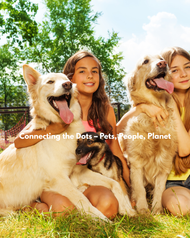Connecting the Dots – Pets, People, Planet
Oct 6th 2025
One Health is more than a buzzword. It is a framework that reminds us our pets, our communities, and the environment are deeply intertwined. When we care for one, we inevitably impact the others.
What is One Health?
One Health is a collaborative, multisectoral, transdisciplinary approach working at local to global levels to achieve optimal health outcomes by recognizing the interconnection between people, animals, plants, and their shared environment.
Human populations are expanding into new areas, increasing contact with both wild and domestic animals. At the same time, shifts in land use and climate create more opportunities for diseases to traverse the human-animal boundary.
Why Pets Matter
Pets are not just family members - they are sentinels. Close contact with cats, dogs, birds, and other companion animals can sometimes reveal environmental or infectious hazards before humans show symptoms.
- Zoonotic disease prevention through vaccination and parasite control reduces risks for both pets and people.
- Responsible antibiotic use in pets helps slow antimicrobial resistance that threatens human medicine.
- Sustainable sourcing and alternative protein options in pet food can lower greenhouse gas emissions and land use pressures.
Every year, diseases like rabies, Salmonella, and West Nile virus move between animals and humans, affecting millions worldwide. Birds often succumb to West Nile virus before neighboring human communities show signs of infection, acting as an early warning system for local outbreaks.
Planetary Connections
Healthy ecosystems underpin our food, water, and air. When habitats degrade, wildlife, livestock, and humans interact in riskier ways, fueling outbreaks and environmental harm.
- Deforestation and intensive farming disrupt wildlife habitats, increasing zoonotic spillover events.
- Climate change alters disease vector ranges, exposing new regions to tick-borne illnesses like Lyme disease.
- The COVID-19 pandemic illustrated how animal-human interfaces can spark global crises.
Sustainable practices in agriculture, urban planning, and pet product manufacturing can help stabilize ecosystems and reduce health risks.
Bridging the Dots in Practice
Turning One Health theory into action demands coordination across sectors. Key steps include:
- Integrative veterinary and human disease surveillance to spot outbreaks sooner.
- Educate pet owners on best practices for vaccinations, parasite control, and antibiotic stewardship.
- Develop sustainable supply chains for pet food and products to minimize environmental footprints.
- Foster collaboration among veterinarians, physicians, environmental scientists, and policymakers.
By working together, these experts can design interventions that benefit pets, protect people, and preserve our planet.
Your role in One Health
Whether you are a pet owner, healthcare professional, or policymaker, you have a part to play:
- Pet owners can stay current with vaccinations and choose eco-friendly products.
- Clinicians and veterinarians can share data and coordinate responses to emerging threats.
- Businesses can adopt sustainable sourcing and support antimicrobial stewardship programs.
- Individuals can advocate for policies that integrate animal, human, and environmental health.
When we connect the dots between pets, people, and the planet, we build healthier, more resilient communities. Start small today - your choices can ripple outward, strenghtening every link in the One Health chain.
References:

